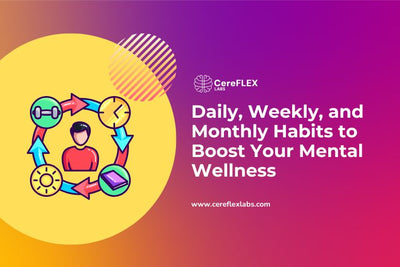Staying mentally sharp is a growing priority for people in high-performance environments. Students aiming for better recall, professionals juggling complex tasks, and biohackers interested in brain optimization are all turning to nootropics to support their cognitive edge.
Among the many options, racetams continue to attract attention. These synthetic compounds—starting with Piracetam in the 1960s—are known for their ability to modulate neurotransmitters and influence learning, memory, and focus.
Some racetams are subtle and steady. Others are fast-acting and energizing. All of them have roots in neuroscience and clinical research, setting them apart from many over-the-counter brain supplements.
This guide breaks down how racetams work, their most common types, how to use them responsibly, and how they compare to more accessible cognitive support systems like Cereflex Labs’ AM/PM Protocol.
Here is the Quick Answer |
|
Racetams are lab-synthesized nootropics used to support memory, learning, and focus by influencing acetylcholine and glutamate systems. Popular examples include Piracetam, Aniracetam, and Phenylpiracetam. These compounds often work best when paired with a choline source and used in moderation. While many users report cognitive benefits, racetams are not approved for sale in Canada and carry import restrictions. For a legal and reliable option, the Cereflex Labs AM/PM Protocol offers full-day brain support using science-backed, compliant ingredients. |

What are racetams?
Racetams are a class of synthetic compounds widely studied for their cognitive-enhancing potential. They belong to the broader category of nootropics—substances that support memory, learning, and mental clarity.
The history of nootropics begins with racetams. In the 1960s, Romanian chemist Dr. Corneliu Giurgea synthesized Piracetam, the first compound in this category. His discovery laid the foundation for modern cognitive enhancement and introduced the word nootropic—defined as a substance that improves cognition while maintaining safety and neuroprotection.
Since then, dozens of racetam derivatives have been developed, each offering unique effects and potencies. While all racetams share a core chemical structure known as the pyrrolidone nucleus, they differ in how they interact with brain chemistry.
Most racetams influence neurotransmitters such as acetylcholine and glutamate, both of which play key roles in focus, memory, and neuroplasticity. Instead of stimulating the brain like caffeine, racetams work by modulating communication between neurons—helping the brain work more efficiently.
They are generally well tolerated, orally bioavailable, and considered low in toxicity. As tools for cognitive support, racetams continue to occupy a central place in discussions about safe and effective brain-enhancing compounds.
Top Racetams and How They Work
Since the discovery of Piracetam in the 1960s, researchers have developed dozens of racetam derivatives. Many are now used—both clinically and off-label—to support learning, memory, and even neurological conditions.
If you're exploring racetams for cognitive enhancement, here’s a breakdown of the most widely used types and how they work:

Piracetam – Cognitive Foundation and Brain Circulation
Piracetam is the original racetam and widely regarded as the foundational nootropic. It modulates AMPA and NMDA glutamate receptors and enhances acetylcholine activity, improving neuronal communication.
It’s also known to increase cerebral blood flow, which may support brain oxygenation and overall function.
A review of 19 studies (1,500 participants) found 61% of adults taking Piracetam experienced mental improvement, compared to 33% of placebo users.1
Users often describe improved verbal fluency, mood, and creativity.
Aniracetam – Cognitive Clarity and Emotional Resilience
Aniracetam is fat-soluble and fast-acting. It boosts both acetylcholine and glutamate transmission while modulating dopamine and serotonin receptors.
This combination supports sharper mental processing and a calming effect on mood—making it popular for managing social anxiety and low motivation.
A 2021 review noted that Aniracetam may counter memory loss caused by beta-amyloid (Aβ) buildup, a factor in Alzheimer’s disease.2
It’s often chosen for users who want both mental clarity and mood stability.
If you're weighing your options, check out how Piracetam and Aniracetam work for brain performance to better understand their unique effects.

Coluracetam – Memory Boost and Sensory Enhancement
Coluracetam supports the high-affinity choline uptake (HACU) system, which is essential for synthesizing acetylcholine. It may improve learning speed, memory formation, and neuroplasticity.
Some users also report heightened colour perception and sharper sensory experiences—making it especially appealing to creatives and visual learners.

Nefiracetam – Long-Term Memory and Mood Regulation
Originally developed for cerebrovascular conditions, Nefiracetam supports acetylcholine signaling and modulates both glutamate and GABA receptors. This dual action helps stabilize mood while promoting memory retention.
In one study, Nefiracetam helped aged rabbits relearn a conditioned response even five weeks after stopping treatment—suggesting potential long-term cognitive benefits.3
Its subtle calming effect without sedation makes it suitable for users seeking balanced cognitive support.

Oxiracetam – Mental Energy and Learning Speed
Oxiracetam enhances choline acetyltransferase activity and increases AMPA receptor binding—boosting both acetylcholine and glutamate function.
It’s one of the more stimulating racetams, often used to improve alertness, mental stamina, and logical thinking.
In a study at 4,000 metres elevation, Oxiracetam improved brain function in military volunteers by enhancing EEG activity and reducing delayed brainwave responses.4
Great for reducing brain fog and improving task efficiency.

Phenylpiracetam – Physical Performance and Cognitive Power
Phenylpiracetam adds a phenyl group to the Piracetam structure, increasing its bioavailability and allowing it to cross the blood-brain barrier faster.
It boosts dopamine, acetylcholine, and NMDA receptor activity—supporting mental resilience, motivation, and cold resistance.
Research shows its R-isomer (R-PhP) acts as a dopamine transporter inhibitor, reduces inflammation, and may offer neuroprotective benefits.5
This racetam is favoured by athletes and high-performers in physically demanding environments.
Pramiracetam – Deep Focus and Cognitive Stamina
Pramiracetam enhances high-affinity choline uptake, fueling acetylcholine synthesis and improving memory consolidation.
Unlike other racetams, it has minimal influence on dopamine or serotonin, making it highly targeted for mental performance without emotional effects.
A review noted Pramiracetam significantly increases nitric oxide synthase (NOS) activity in the cortex, which may benefit learning and synaptic plasticity.6
It’s often used for intense study or focus-heavy tasks requiring sustained attention.
Potential Side Effects and Safety
Racetams are generally well tolerated and considered low in toxicity. But like any nootropic, how they affect you depends on dosage, choline levels, and your personal brain chemistry.
Understanding potential side effects—and how to prevent them—is essential to safe use.
Common Side Effects of Racetams
The most frequently reported side effect is headache. This typically occurs when acetylcholine levels are too low to support the increased demand triggered by racetams.
Other occasional side effects include:
- Irritability
- Nausea or digestive discomfort
- Brain fog (especially when choline is depleted)
- Fatigue or overstimulation depending on the compound and dose
These reactions are usually mild and subside with proper dosing or the addition of a choline source.
Why Choline Matters
Racetams increase the brain’s need for acetylcholine, a key neurotransmitter for memory and cognition. Without enough choline in your system, your brain may struggle to keep up—leading to what’s commonly called a “racetam headache.”
To avoid this, it’s recommended to pair racetams with a quality choline supplement such as Alpha-GPC or CDP-Choline.
Not only does this reduce side effects, it also helps racetams work more effectively. In fact, many users find that racetams don’t deliver noticeable benefits without this essential support.
Long-Term Safety
Among racetams, Piracetam has the longest and most documented safety record. Others, like Aniracetam or Oxiracetam, also show promise in both animal studies and limited human trials. Still, comprehensive long-term studies on healthy individuals are rare.
Early evidence suggests racetams have a wide safety margin when used in moderate doses. That said, long-term impacts—especially with daily or high-dose use—are not fully understood. Staying informed, tracking your usage, and consulting a healthcare provider can help manage any emerging risks.
Cycling and Safe Usage Tips
Many experienced users cycle racetams to reduce the risk of tolerance and maintain consistent results. This might involve using a racetam for several weeks, followed by a short break. While not required for all compounds, cycling gives the brain time to reset and can improve sensitivity over time.
To use racetams responsibly:
- Start with a single compound to gauge your response
- Avoid large doses before knowing your personal tolerance
- Keep a journal of effects, dosages, and side effects
- Stick to research-backed compounds—avoid unverified or experimental derivatives
When treated as tools—not shortcuts—racetams can be effective allies in a safe cognitive support strategy.
Conclusion
acetams are among the most widely recognized and studied nootropics in the cognitive enhancement space. From Piracetam’s foundational role to fast-acting options like Phenylpiracetam and Aniracetam, this class of compounds offers a variety of mechanisms to support memory, focus, and mental clarity—especially when paired with the right choline source.
That said, responsible use is key. Not all racetams work the same way, and individual responses can vary based on dose, stacking, and neurochemical differences. Understanding how each compound functions, being mindful of side effects, and cycling when needed can help optimize results while minimizing risk.
For those looking to support brain health daily—without relying on grey-market synthetics—Cereflex Labs offers a legal and carefully formulated alternative.
The AM/PM Protocol from Cereflex Labs includes:
- AM Brain Morning Formula – Used to support attention, memory performance, and mental energy throughout the day.
- PM Cognitive Support Evening Formula – Formulated to help regulate stress, support relaxation, and assist with overnight cognitive recovery.
Each formula includes ingredients traditionally used to support cognitive performance, circulation, and antioxidant protection. The system is designed with research-backed dosages, GMP manufacturing standards, and no stimulants—ideal for those seeking long-term brain wellness.
Support cognitive clarity with a balanced, legal approach—start with the Cereflex Labs AM/PM Protocol.






